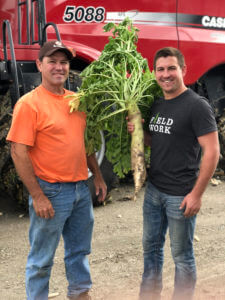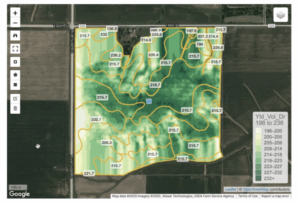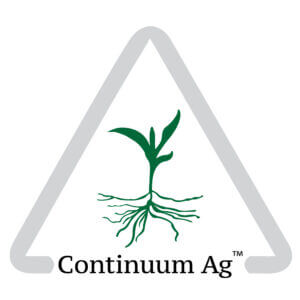Here’s why Evergreen Climate Innovations is excited about our investment in Continuum Ag, an Iowa-based startup run by farmers, for farmers, to drive the adoption of regenerative agriculture practices that improve sustainability, increase profits, and sequester carbon in the soil.
 Meet Mitchell Hora. Mitchell is a farmer in Iowa. His father is a farmer. His grandfather is a farmer, as was his great grandfather. In fact, Mitchell is a seventh generation farmer. Without a doubt, Mitchell Hora was born to farm.
Meet Mitchell Hora. Mitchell is a farmer in Iowa. His father is a farmer. His grandfather is a farmer, as was his great grandfather. In fact, Mitchell is a seventh generation farmer. Without a doubt, Mitchell Hora was born to farm.
Regenerative agriculture: a new way to farm
There’s a new trend in farming known as “regenerative agriculture.” Simply put, regenerative ag is a set of practices that focuses on optimizing soil health. While there are a variety of things that can be done to improve soil health, the two core practices to regenerative ag are:
- No-till farming
- Cover crop integration
 Mitchell is a people person, a real extrovert. And boy does he love to talk—the guy can talk the hind leg off a donkey—especially when it comes to sustainable farming. You should check out his podcast Field Work, produced by American Public Media. Hosted by two commercial row-crop farmers, Field Work is a podcast that provides space for frank, realistic discussions about the benefits and challenges of sustainable agriculture. With his co-host Zach Johnson, Mitchell explores the successes and challenges farmers experience as they adopt new practices, without greenwashing over the difficulties.
Mitchell is a people person, a real extrovert. And boy does he love to talk—the guy can talk the hind leg off a donkey—especially when it comes to sustainable farming. You should check out his podcast Field Work, produced by American Public Media. Hosted by two commercial row-crop farmers, Field Work is a podcast that provides space for frank, realistic discussions about the benefits and challenges of sustainable agriculture. With his co-host Zach Johnson, Mitchell explores the successes and challenges farmers experience as they adopt new practices, without greenwashing over the difficulties.
To plow or not to plow? That is the question.
Plowing or tilling soil has been done for thousands of years. The ard—an early predecessor to the plow—dates back to 6000 BC, with evidence of its use in ancient Egypt, Europe, India and the Near East. Why plow? To aerate and loosen compacted soil, bury any crop remnants, and break up weed roots. Makes sense. But plowing also disrupts and destroys the rich biodiversity below the surface where there’s a thriving ecosystem of fungi, worms, and more microbes than stars in the sky. Plowing and tilling also encourage erosion, causing the soil to degrade, thereby increasing the need for fertilizer.
 Most farmers are risk averse. They adopt the same practices used by the previous generation, occasionally adding a new piece of equipment to improve efficiency, and otherwise sticking to what’s tried-and-true. A conservative approach makes sense. After all, a farmer only gets about 40 “at-bats” in a career. A lot is riding on the decisions made each growing season, so it’s awfully tough to roll the dice on a pig in a poke. If yield falls short, it could be the difference in meeting debt obligations for the season. But the Hora family? Well, they’re a little… different. Unlike most farming families, the Horas seek out innovative approaches, all in the name of optimizing yield and improving sustainability. Not every experiment works out, but they know you can’t make an omelet without breaking eggs. The Hora family began integrating regenerative farming practices way back in 1978—nearly 40 years before the trend began to garner mainstream attention.
Most farmers are risk averse. They adopt the same practices used by the previous generation, occasionally adding a new piece of equipment to improve efficiency, and otherwise sticking to what’s tried-and-true. A conservative approach makes sense. After all, a farmer only gets about 40 “at-bats” in a career. A lot is riding on the decisions made each growing season, so it’s awfully tough to roll the dice on a pig in a poke. If yield falls short, it could be the difference in meeting debt obligations for the season. But the Hora family? Well, they’re a little… different. Unlike most farming families, the Horas seek out innovative approaches, all in the name of optimizing yield and improving sustainability. Not every experiment works out, but they know you can’t make an omelet without breaking eggs. The Hora family began integrating regenerative farming practices way back in 1978—nearly 40 years before the trend began to garner mainstream attention.
Thou shalt not till
It’s the first commandment of regenerative ag. As Mitchell says, “You may feel the urge to till, but you must resist. There’s a better way.” In addition to not tilling the soil, the other key step to regenerative ag is the addition of cover crops. Cover crops—as opposed to cash crops that are harvested and sold for profits (e.g. corn, soybeans)—are used to help improve and protect soil. Their roots help break up soil and improve biodiversity, reducing the need for fertilizers. And above ground they help to smother weeds, control pests, and provide a natural armor to prevent erosion, especially in between growing seasons when fields are often left bare. These two relatively simple practices can dramatically improve soil health by increasing organic content and biodiversity and preventing erosion, all while reducing operating costs. Cover crop seeds do present an added expense, but farmers typically reduce total expenditure by not having to till the fields every season, which can save $10-30 per acre.
 Mitchell’s not only a farmer and a podcast host. He’s also a climate tech entrepreneur. Growing up on a farm where regenerative ag reigns, Mitchell decided to make hay while the sun shined. So, he went whole hog and founded Evergreen Climate Innovation’s newest portfolio company Continuum Ag, a software startup on a mission to help farmers deploy sustainable agriculture practices and improve profitability.
Mitchell’s not only a farmer and a podcast host. He’s also a climate tech entrepreneur. Growing up on a farm where regenerative ag reigns, Mitchell decided to make hay while the sun shined. So, he went whole hog and founded Evergreen Climate Innovation’s newest portfolio company Continuum Ag, a software startup on a mission to help farmers deploy sustainable agriculture practices and improve profitability.
TopSoil: a platform to manage soil health
Continuum Ag’s flagship product, TopSoil, is a SaaS software platform that helps farmers aggregate and benchmark soil health data and implement regenerative agriculture practices.

In Mitchell’s words, “TopSoil scales the science of agriculture, so farmers and their advisors can optimize their art. When it comes to designing a regenerative ag strategy that’s right for that customer, users find actionable insights at their fingertips. Our platform utilizes data to provide actionable insights, allowing customers to make informed decisions to directly implement sustainable systems and drive profits.” The Continuum Ag team is just getting started, but TopSoil already has thousands of farmers from 38 states and 15 countries using the platform. We couldn’t be more excited about our latest investment in Continuum Ag, but there’s more to this story…
 Screenshot of the TopSoil platform
Screenshot of the TopSoil platform
Soil: nature’s other carbon sink
Regenerative ag is sustainable farming at a lower cost, but the benefits just begin there. Trees are often thought of as nature’s go-to carbon sequestration solution. Photosynthesis extracts CO2 from the atmosphere and converts the carbon into wood. Easy peasy. But until recently, soil has gone largely overlooked as another very effective nature-based solution for carbon removal. Several scientific studies have concluded that carbon-depleted soils have the potential to remove and sequester 4-5 GtCO2e per year (8-10% of global annual emissions), with some studies estimating the potential as high as 8 GtCO2e per year.
 Credit: Frontiers in Climate 2019
Credit: Frontiers in Climate 2019Regenerative agriculture practices directly increase soil carbon content by extracting CO2 from the atmosphere and then sequestering it in the soil. Regenerative ag clearly has a role to play in addressing the climate crisis. Planting more trees is important, and protecting remaining forestland from further deforestation is critical. However, applying regenerative ag to existing farmland offers a remarkably elegant, practical, and scalable nature-based climate solution simply because it’s a better way to farm. The more carbon in the soil, the more fertile it is. But imagine if farmers could be compensated for the carbon they sequestered in their soil…
The carbon markets cometh
Ask any economist how to solve climate change and each and every one of them will tell you the same exact answer: a universal price on carbon. By internalizing the true cost of pollution into the price of commodities like energy, fuel, cement, steel, fertilizer, food, clothes, and all those plastic pieces of junk kids fawn over at the Chuck E. Cheese prize counter, the market will quickly shift to “green” options which, it turns out, are actually far less expensive. I agree with the economists, but I suspect this globally accepted true cost of carbon will be universally adopted when pigs fly, so we may need to take a more realistic approach. Still, they’re on the right track. 27 countries have implemented a carbon tax at rates ranging from less than $1/ton to more than $100/ton. In parallel, several mandatory and voluntary carbon markets have been launched at different levels and in different regions. How, exactly, soil sequestration fits into these carbon trading programs is still somewhat unclear, as scientists continue to study the biological mechanisms to ensure processes can be accurately tracked and accounted for. But we can be confident that agricultural soil will have a big role to play, and the market is starting to show its cards. Just two weeks ago, Nestle announced its commitment to invest $1.3 billion in regenerative agriculture. As carbon markets continue to mature and evolve, Continuum Ag is working closely with the farming community to facilitate a smooth transition to regenerative ag.
Monetizing soil carbon is just a click away
The Continuum Ag team is committed first and foremost to helping farmers optimize their soil health. But they also fully recognize the massive climate opportunity that can—no, must—be seized by the farming community. Farmers hold the key to a very powerful negative emissions weapon, and Continuum Ag is well-positioned to facilitate its deployment.
 Credit: Continuum Ag
Credit: Continuum Ag
By capturing their soil health data in the TopSoil platform, farmers will be able to readily monetize their carbon sequestration activities by selling offsets into carbon markets. TopSoil maintains extensive data over time, including soil carbon content and detailed land management practices, to ensure the quality and traceability of its customers’ offsets. Continuum Ag is working closely with carbon market platforms to enable easy access for the farmers in their network. In parallel, the Continuum team is also working closely with a wide range of large enterprise customers to help them achieve their sustainability goals. [Reach out to me for more info on this topic!]

Much work to be done
Some folks think trying to prevent climate change is like shutting the barn door after the horse has bolted. But not me, and not Mitchell. We’re all in this together and we all need to play our part. There’s no panacea, no silver bullet. We need to deploy existing technologies and innovate new ones. We need to decarbonize electricity and electrify everything. And we need to remove carbon from the atmosphere whenever and wherever and however possible, starting now. From direct air capture to planting trees to regenerative ag—negative emissions solutions are critical. Will Mitchell Hora and the Continuum Ag team have a big impact on the sustainable agriculture movement and its effect on climate? You can bet the farm on it. @mediumpauly Read more of Evergreen Climate Innovation’s news and perspectives on Medium.